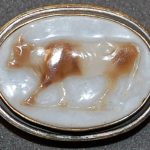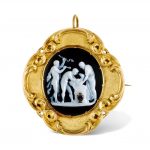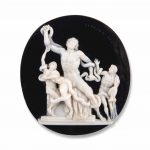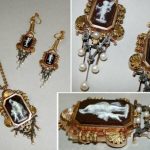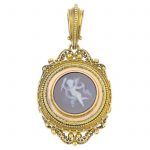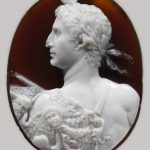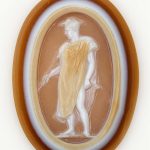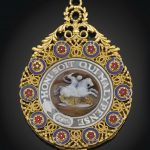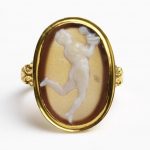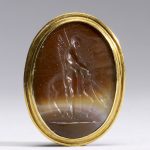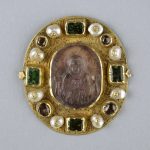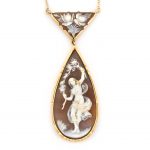Sardonyx is a banded variety of the oxide mineral chalcedony and consists of red bands. The ancient Romans entered battle carrying amulets of sardonyx engraved with Mars, the god of war. This was believed to bestow courage in battle. In Renaissance Europe, wearing sardonyx was believed to bestow eloquence. A traditional Persian belief is that it helped with epilepsy. Sardonyx was traditionally used by English midwives to ease childbirth by laying it between the breasts of the mother. Reference: Wikipedia
Sardonyx cameo engraved with a cow walking to the left. Culture/periodRoman Imperial (early) term details Date1stC-2ndC
Reference: © The Trustees of the British Museum
An 18th-19th century sardonyx cameo and gold brooch/pendant, by Amastini The oval sardonyx cameo, probably late 18th century, depicting a sacrifice, a robed priest oversees the sacrifice of a sheep while a nude figure, draped with the skin of a sheep, holds aloft a writhing snake whilst playing a pipe, within a gold repoussé frame, circa 1840, cameo signed A.MASTINI.R, cameo dimensions 3.8 x 3.2cm
Sold for £10,625 inc. premium at Bonhams in 2016
AN IMPORTANT SARDONYX CAMEO, BY CERBARA The large oval agate cameo depicting Laocoon and His Sons, after Antonio Canova, circa 1820, 5.9cm Signed CERBARA FECIT, probably for Giuseppe Cerbara
Sold for GBP 10,625 at Christies in 2016
Victorian Sardonyx Cameo Pendant and Earring Set 18 kt. yellow gold, comprising a pendant and pair of earrings, each set with one sardonyx cameo depicting classical figures, enhanced with assorted small pearls, the pendant suspended from a 10 kt. yellow gold chain.
Sold for $5,377 (includes buyer’s premium) at Doyle New York in 2003
A mid Victorian gold agate cameo pendant. The sardonyx cameo carved to depict the Genius of Light, with cannetille surrounds, hinged to reveal a glazed locket interior, suspended from a cannetille surmount. Length 6.6cms. Weight 27.9gms. CONDITION Overall condition good. Some surface scratches/wear and small dents in keeping with general age and wear. Wear to the gilt finish. Glazed panel in good condition. Agate in good condition. Diameter of agate 17.5mms. Please see the Important Notices for Purchasers for coloured gemstones. Width (at widest) 34mms.
Sold for £860 at Fellows in 2018
Sardonyx cameo portrait of the Emperor Augustus Period: Early Imperial, Claudian Date: ca. A.D. 41–54
The cameo depicts Augustus as a triumphant demigod wearing the aegis, a cape usually associated with Jupiter and Minerva. Here, it is decorated with the head of a wind god, perhaps intended as a personification of the summer winds that brought the corn fleet from Egypt to Rome and so an oblique reference to Augustus’s annexation of Egypt after the defeat of Mark Antony and Cleopatra at Actium in 31 B.C.
Reference: The Metropolitan Museum of Art
Cameo with Mercury Roman Imperial Period 1st century
Oval sardonyx cameo in three layers: pale brown over white over brown. Mercury standing with head in profile to left and body in three-quarter view. He wears a chlamys and petasos, and holds a caduceus in his right hand and purse (?) in left. Ground line and raised border. Left foot and ground line damaged.
Reference: Museum of Fine Arts Boston
Great Britain, The Most Noble Order of the Garter a magnificent, large and unusual Lesser George sash badge, Cambridge No. 10, circa 1835, unsigned, in gold, sardonyx and enamels, constructed as two plates joined by a plain gold edge band to which is fitted the scroll-mount for suspension and which is engraved ‘No. 10’ in the style of other Cambridge pieces; one face with a finely-carved central sardonyx cameo of St George on horseback slaying the dragon in very high relief and of outstanding craftsmanship, the Garter motto HONI SOIT QUI MAL Y PENSE, around bordered by 10 gold lover’s knots and 10 red-enamelled roses within blue Garters to represent the collar of the Order; the other face with a central finely-detailed gold model of St George and the dragon superimposed on translucent red enamel over an intricately-patterned guilloché base, the blue-enamelled Garter around with motto HONI SOIT QUI MAL Y PENSE in applied capital letters in Gothic script, weight 73.1g all in, a couple of scratches to the gold at lower edge and with some traces of old lacquer, in excellent condition overall height (from tongue at the base of the badge to top of suspension) 79mm, width 54.7mm
Sold for 93,750 GBP at Sothebys in 2018
Vertical oval cameo, depicts Psyche naked and running or dancing to right. She wears a butterfly’s wing in her hair, and is feeding a butterfly, holding up the butterfly in her left hand and a dish in the right. Set in a gold ring.
This gem was part of the collection of the Reverend Chauncy Hare Townshend (1798-1868), who bequeathed his important collection to the South Kensington Museum in 1869. Although the gemstone collection is not as comprehensive as that found at the Natural History Museum, it is of particular historic interest as its formation pre-dates the development of many synthetic stones and artificial enhancements. All the stones were mounted as rings before they came to the Museum. Some are held in the Sculpture Section, other more elaborately mounted ones in the Metalwork Section. As well as being a clergyman, collector and dillettante, the Reverend Townshend wrote poetry. He met Robert Southey in 1815 and through him the Wordsworths, the Coleridges and John Clare. He was a friend of Charles Dickens and dedicatee of his novel ‘Great Expectations’.
Reference: © Victoria and Albert Museum
Sardonxy gem with Intaglio with Bellerophon and Pegasos
Gem engraving was a major art form in ancient Greece and Rome. Precious stones were thought to have healing and protective powers and were used as amulets and seals as well as jewelry. Engraved or incised gems, known as intaglios, were often decorated with winged creatures, such as the sphinx and the griffin. The immortal winged horse Pegasos sprang from Medusa’s neck when she was decapitated by the hero Perseus. While Pegasos was drinking from a spring at Corinth, the hero Bellerophon tamed him with a bridle given to him by the goddess Athena.
Reference: The Walter Art Museum
